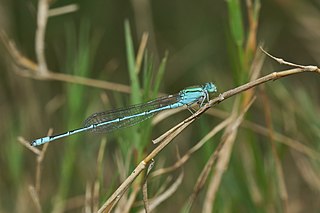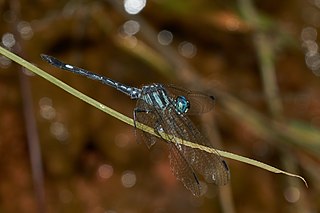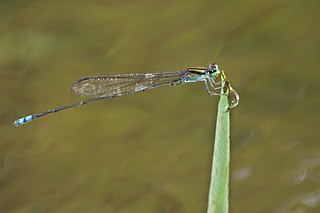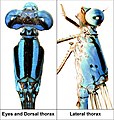
The blue riverdamsel, Pseudagrion microcephalum is a common species of damselfly in the family Coenagrionidae. It is also known as the blue sprite and blue grass dart.

Esme longistyla is damselfly in the family Platycnemididae. It is commonly known as the Nilgiri bambootail. It is endemic to Western Ghats in India.

Lestes praemorsus is a damselfly species in the family Lestidae. It is commonly known as the scalloped spreadwing or sapphire-eyed spreadwing. It is very widely distributed from India to China and south to New Guinea.

Copera vittata is a species of damselfly in the family Platycnemididae. It is native to Asia, where it is widely distributed from India to Indonesia. It is known commonly as the blue bush dart. There are several subspecies and it may represent a species complex.

Indolestes gracilis is a species of damselfly in the family Lestidae. It is known only from Sri Lanka, South India and Cambodia.

Lestes elatus is a species of damselfly in the family Lestidae, the spreadwings. It is known commonly as the emerald spreadwing. It is native to India, Thailand and Sri Lanka.

Amphiallagma parvum, little blue or azure dartlet, is a species of damselfly in the family Coenagrionidae. This species can be found in many South Asian countries including India, Sri Lanka, Myanmar, Thailand, Nepal, and probably in Bangladesh.

Pseudagrion rubriceps, saffron-faced blue dart, is a species of damselfly in the family Coenagrionidae. It is found in many tropical Asian countries.

Bradinopyga geminata is a species of dragonfly in the family Libellulidae known commonly as the granite ghost. It is native to India, Sri Lanka and Thailand, where it is a common and widespread species.

The black marsh skimmer, or light-tipped demon, is a species of dragonfly in the family Libellulidae. It is found in India, Sri Lanka and Thailand.

Pseudagrion decorum, elegant sprite or three striped blue dart, is a species of damselfly in the family Coenagrionidae. It is found in many tropical Asian countries.

Hylaeothemis apicalis or the Blue Hawklet is a species of dragonfly in the family Libellulidae, endemic to India.

Pseudagrion indicum, yellow-striped blue dart or yellow-striped dart, is a species of damselfly in the family Coenagrionidae. It is found only in Western Ghats of India.

Disparoneura quadrimaculata, black-winged bambootail is a damselfly species in the family Platycnemididae. It is a widely distributed species in India.

Elattoneura tetrica, black and yellow bambootail is a damselfly species in the family Platycnemididae. It is endemic to Western Ghats in India.

Esme cyaneovittata is damselfly in the family Platycnemididae. It is endemic to Western Ghats in India, south of Palakkad Gap.

Indosticta deccanensis, saffron reedtail is a damselfly species in the family Platystictidae. It is endemic to Western Ghats in India.

Protosticta sanguinostigma, red spot reedtail, is a damselfly species in the family Platystictidae. It is endemic to Western Ghats in India. It is known to occur only in a few localities.

Davidioides martini, Syrandiri clubtail, is a species of dragonfly in the family Gomphidae. It is known only from the Western Ghats of India.

Pseudagrion australasiae is a species of damselfly in the family Coenagrionidae. It is found in India, China, Indonesia, Malaysia, Myanmar, Singapore and Thailand.


























